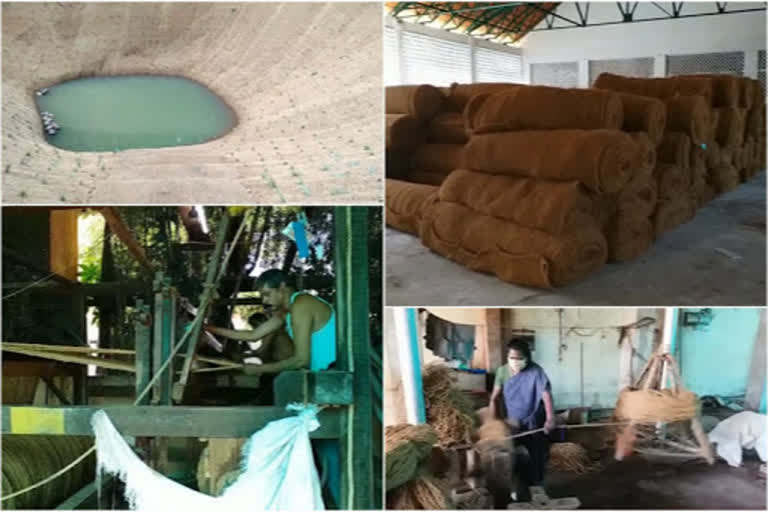Alappuzha: The canals and streams in Kerala are all undergoing a makeover, with a 'golden drape' falling over their enticing slopes and curves of the banks.
The 'magic make up' behind the charm of these water bodies, after the special makeover sessions, is the coir geotextile, locally called ‘Kayar Bhoovastram’.
Coir geotextile is an eco-friendly, fabric made from woven coir (from coconut husk fibre), that is used to check soil erosion during the Kerala rains. It is spread over the banks of water bodies like the ponds, and the walls of streams, bunds, farms and canals to protect the soil and preserve water.
Coir geotextile is mainly being sourced from the State Government establishments - Coir Corporations, Coir Fed and Foam Mattings - to be spread along the banks of water bodies and other environmentally vulnerable areas in the limits of each Local Self Governance body in the State. As of now, the Coir Corporation provides coir geotextiles to 7 districts, while Foam Mattings and Coir Fed cater to four and three districts respectively.
This project is also meant to be a mainstay for more than 2 lakh families who are traditional coir workers in Kerala.
Coir Geotextile: Kerala Govt's initiative to conserve water bodies, soil in the state The coir geotextiles spread over the earth along the water bodies and other areas biodegrades within 5 to 6 years naturally. This adds fertility to the soil and helps in the growth of thick vegetation. Coir Bhoovastra is known to prevent soil erosion, especially during rains, as the strong, waterproof fibre withstands the test of Kerala monsoons. It also adds quality to the soil texture as it degrades over a short period naturally.
The government’s project to spread coir bhoovastra can help conserve the soil and water in Kerala during rains to a great extent. Expert traditional coir labourers are involved in making Bhoovastram by weaving the coconut husk fibre or by a special netting method, without weaving.
Experiments have proven that the use of well-processed coir geotextile improves the fertility of the soil.
These golden fibres of coir have the special quality of letting the liquids pass through while withholding all particles. Geotextile preserves the natural ecosystem of an area for a particular period of time organically. In some foreign countries, geotextiles are being used even in road construction.
Let us have a look a the major geological features of the Coir Bhoovastra.
- Prevents soil erosion by reducing and regulating the water currents
- Absorbs 5 times water than its actual weight
- Retains the moisture in the soil and reduces the atmospheric temperature
- Organically degenerates and degrades making the soil fertile
Currently, there are two types of coir geotextile - woven and non woven - classified based on the technique of manufacture. The manner of application is also different for both.
First, the area where the geotextile is to be spread is cleared. Then, on the top surface, a 30- centimetre deep pit or depression is dug up. In this pit, the coir geotextile is spread out and fastened with the help of bamboo poles. Along the slopes, grass seeds can be sown after spreading the geotextile.
The degree of prevention of soil erosion in sloppy areas is proportional to the mesh size of the geotextile used. A geotextile with a mesh size (the size of the one ‘eyelet’ in the netted fabric) of one inch can prevent erosion up to 30 per cent, while that with half an inch mesh size can retain soil up to 50 per cent. The geotextile with a quarter-inch mesh size is said to be 100 per cent effective in preventing soil erosion in slopes on the earth.
The government has designed several special projects to cover the length and breadth of Kerala using coir geotextile. These projects will be implemented through the Local self-government bodies in the respective regions. The government has intensified the work of spreading coir geotextile through workers under MGNREGA project also.
Kerala, which has 44 rivers flowing through the state, records an average of 3000-millimetre annual rainfall. Despite this, water is scarce in many parts of the state during peak summer. As per statistics, about 80- 120 units of soil erodes from one hectare. Coir geotextiles can help to a large extent in order to put a check on soil erosion and to help reduce water scarcity.
The work of spreading coir geotextile in different parts of Alappuzha district is on now. It is certain that coir bhoovastram will be a revolutionary step forward to organically conserve the streams and canals of Kerala.
Also Read:Adv association wants physical sittings to be stopped till June 30 as cop tests positive
